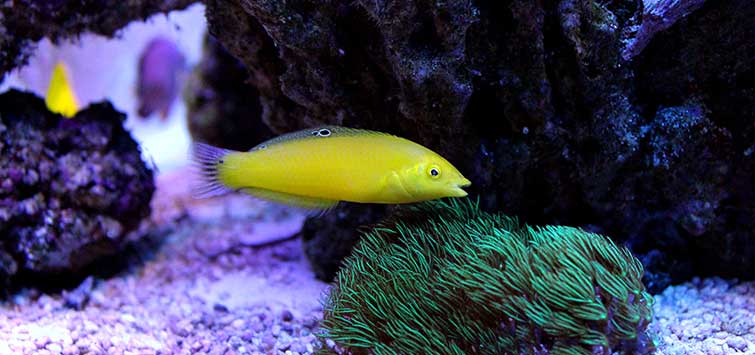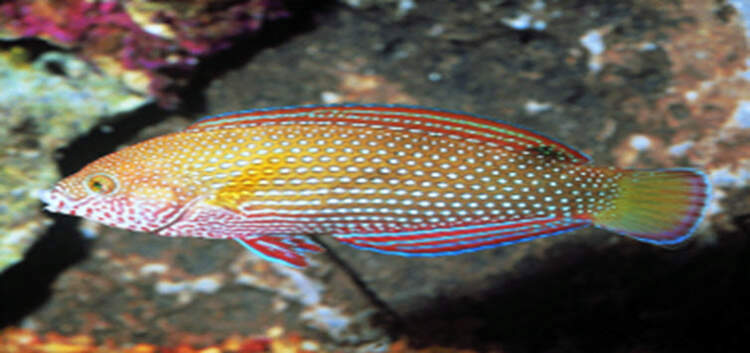Halichoeres melanurus
Common Names: Dusky-tail rainbowfish, Hoeven’s wrasse, melanurus wrasse, neon wrasse, orange-tipped rainbowfish, pinstripe wrasse, tailspot wrasse, yellow-lined wrasse
Type Locality: Banda Islands, Indonesia
Range: Western Pacific: Japan south to the Great Barrier Reef and east to Samoa and Tonga
Taxonomic Troubles: Originally described as Julis melanurus. You may also see it called H. hoevenii.
Size: 12 cm (5 inches) or a little larger.
Preferred Water Chemistry: Tropical marine.
Difficulty: Very hardy. The only likely challenge is getting a wild-caught specimen to recognize nonliving foods. Since they eat a wide variety of prey, they will sample new things, and it is not too difficult to wean them onto meaty preparations. They do not normall
Tank Setup: A sandbed of at least 3 inches of very fine sand is necessary for this wrasse, as it burrows into the sand to sleep and to escape perceived danger. A close-fitting top without substantial openings is necessary to keep this wrasse in the aquarium. Typicall
Feeding: A predator of motile invertebrates. Because they will eat flatworms and parasitic snails, one is often purchased to combat an infestation, and, fortunately, when it has cleaned up the unwanted critters, it makes a colorful and interesting fish that will f
Breeding: A protogynous hermaphrodite. A male will control a harem of several females. If the male disappears, the dominant female will immediately behave like a male, spawning with the other females, but it takes a few weeks for it to become a functional male. It has not yet been bred and reared successfully in captivity.
Fish Description
Has the fusiform shape common to wrasses in this group—elongated and tapered at both ends. This is a fast-swimming fish, and it can quickly disappear by diving into the sand. A basic blue color is accented by thin, red horizontal stripes from snout to tail. Yellow and green on the face complete the color scheme. Adult coloration is more vivid than that of the juveniles.
Notes
This is a highly underappreciated species. Colorful, peaceful, of manageable size, and inexpensive, it deserves more attention. The fish is problematic for a reef setup (unless your only invertebrates are corals), but it can star in a fish-only system. Wrasses in general are inquisitive and always ready to eat, and the melanurus wrasse is no exception. It will patrol live rock structures, eyeing out any tasty tidbits, and appreciates a mature system with resident ’pods. It will also grub for invertebrates in the sand. The beautiful colors and lively behavior will entertain you, and its live-and-let-live attitude is a welcome bonus.

.png?h=595&iar=0&w=2781&hash=5FD5E69473BCC22199FBFA2FB71B6033)



